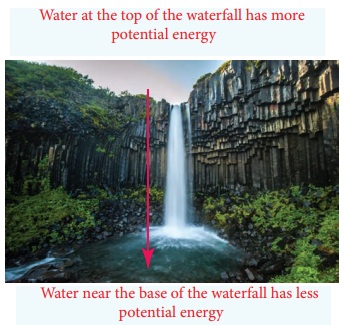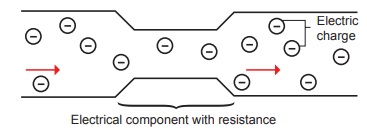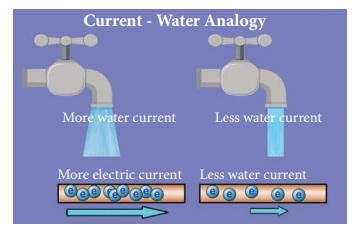Electricity | Term 2 Unit 2 | 7th Science - Potential difference (v) | 7th Science : Term 2 Unit 2 : Electricity
Chapter: 7th Science : Term 2 Unit 2 : Electricity
Potential difference (v)
Potential
difference (v)
Electrical charges need energy to push them along
a circuit.
Water always flows from higher to lower ground.
Similarly an electric charge always flows from a point at higher potential to a
point at lower potential.
An electric current can flow only when there is a
potential difference (V) or P.D.
The potential difference between any
two points in the circuit is the amount of energy needed to move one unit of
electric charge from one point to the other.
1. Unit of
potential difference
Did you ever notice the precautionary board while
crossing the railway track and the electrical transformer? What does the word
high voltage denotes?

The term metioned in the board volt is the measurement
for the electric potential difference.
The SI unit of potential difference is volt (V).
potential difference between two points is measured by using a device called
voltmeter.

The electric current flow from the
higher potential level to the lower potential level is just like the water
flow.
2. Electrical conductivity and Resistivity

Resistance (R)
An electrical component resists or hinders the
flow of electric charges, when it is connected in a circuit. In a circuit
component, the resistance to the flow of charge is similar to how a narrow
channel resists the flow of water.
The higher the resistance in a component, the
higher the potential difference needed to move electric charge through the
component. We can express resistance as a ratio.
Resistance of a component is the ratio of the
potential difference across it to the current
flowing through it.
R = V/I
The S.I unit of resistance is ohm
Greater the ratio of V to I, the greater is the
resistance
Electrical conductivity (σ)
Electrical conductivity or specific conductance is
the measure of a material's ability to conduct an electric current. It is
commonly represented by the Greek letter σ (sigma) The S.I Unit of electrical
conductivity is Siemens/meter(S/m)
Electrical resistivity (ρ)
Electrical resistivity (also known as specific
electrical resistance, or volume resistivity) is a fundamental property of a
material that quantifies how strongly that material opposes the flow of
electric current. The SI unit of electrical resistivity is the ohm-metre (Ω.m).

3. Analogy of
Electric Current with Water Flow
An electric current is a flow of electrons through
a conductor (like a copper wire). We can't see electrons, however, we can
imagine the flow of electric current in a wire like the flow of water in a
pipe.
Let us see the analogy of flow of electric current
with the water flow.
Water flowing through pipes is pretty good
mechanical system that is a lot like an electrical circuit. This mechanical system
consists of a pump pushing water through a closed pipe. Imagine that the
electrical current is similar to the water flowing through the pipe. The
following parts of the two systems are related
* The pipe is like the wire in the electric
circuit and the pump is like the battery.
* The pressure generated by the pump drives water
through the pipe.
* The pressure is like the voltage generated by
the battery which drives electrons through the electric circuit.
* Suppose, there are some dust and rust that plug
up the pipe and slow the flow of water, creating a pressure difference from one
end to the other end of the pipe. In similar way, the resistance in the
electric circuit resists the flow of electrons and creates a voltage drop from
one end to the other. Energy loss is shown in the form of heat across the
resistor.

Related Topics